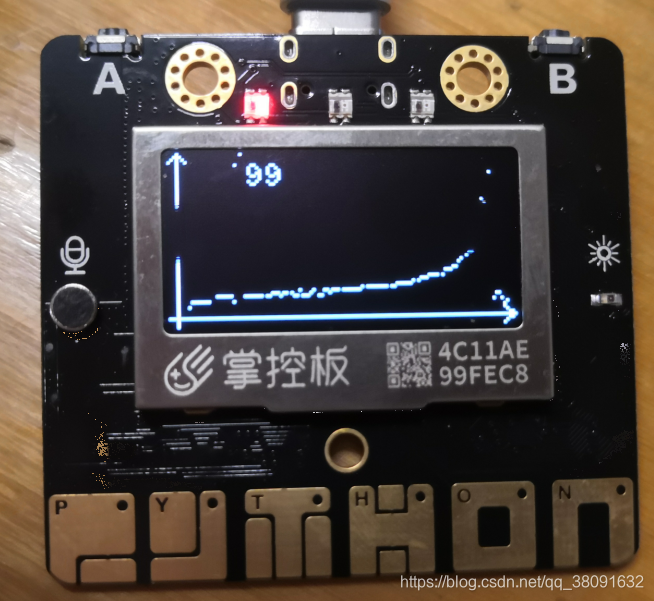环境
掌控板2.0
语言micropython
待办
显示坐标轴,亮灯;显示一个点,显示屏的精度(横纵坐标点数)
数组归一化;显示txt中数组的折线图
micropython实现fft
读取wav文件读取音频数据
内容
注意项:
判断最大值
方法一:字符串转整形int()——优
方法二:数值通过excel表格设置相同位数,不足的补零,然后直接字符串对比
a.txt
1
2
3
4
5
main.py
from mpython import *
import neopixel
import math
import time
#数值必须是同位数,若存在2位和3位,则2位补零。原因对比的是字符串,若实现字符串转数字可以不用该限制
def max_val(data):
max_value="0"
i=0
temp=data[i]
x=len(data)
print(x)
while i<(x-1):
print("max",int(max_value))
print("temp",int(temp))
if int(temp)>int(max_value):
#if temp>max_value: #数据同位数判断
max_value=temp
print("temp>max_value")
i=i+1
temp=data[i]
print("i",i)
print("temp",temp)
print("max=",max_value)
return max_value
def show_max_value(data):
#temp=result[0]
temp=max_val(data)
#temp=',1234'
print(temp)
oled.fill(0)
oled.DispChar((temp), 0, (1-1)*16, 1)
#oled.DispChar(('12345'), 0, (2-1)*16, 1)
#oled.DispChar((result[2]), 0, (3-1)*16, 1)
#oled.DispChar((result[3]), 0, (4-1)*16, 1)
oled.show()
def show_x_y(x,y,x_max,y_max,x_point,y_point):
a=int(x*x_point/x_max)
b=int(y*y_point/y_max)
oled.pixel(7+a,56-b,1) #(0,0)->(7,56) (x,y)->(7+x,56-y)
oled.show()
return
#右上角显示停止的时间
def show_stop_time(stop_x):
start_x=127-7*3 #两位数值,一位7*16,显示屏最大宽为127
#stop_x显示的数值,start_x横坐标起始点,0纵坐标起始点,1显示方式为白色点
oled.DispChar((stop_x), start_x, 0, 1)
oled.show()
return
def search_array(data):
i=0 #x
temp=int(data[i]) #y
y_max=int(max_val(data))
x_max=len(result) #是否需要减一
x_point=120
y_point=56
print("xline=",x)
#temp max
tempx=0
tempy=0
stop_x=0
while i<(x_max-1):
show_x_y(i,temp,x_max,y_max,x_point,y_point)
temp_k=temp-tempy
tempy=temp
#if temp_k<0:
# tempy=0
#elif temp_k>50:
if temp_k>50:
stop_x=i
print("It's time to stop flooding water.---------------------------")
show_stop_time(stop_x)
i=i+1
temp=int(data[i])
time.sleep(0.1)
return
#___main
file_path="a.txt"
f = open(file_path, 'r')
result = f.read().split('\r\n') #get data
f.close()
print(result)
search_array(result)
from mpython import *
import neopixel
import time
def light():
ws2812_P7 = neopixel.NeoPixel(Pin(Pin.P7), n=3, bpp=3, timing=1)
ws2812_P7.brightness(10 / 255)
ws2812_P7[0]=(255, 0, 0)
ws2812_P7.write()
return
def light_close():
ws2812_P7 = neopixel.NeoPixel(Pin(Pin.P7), n=3, bpp=3, timing=1)
ws2812_P7.brightness(10 / 255)
ws2812_P7[0]=(0, 0, 0)
ws2812_P7.write()
return
#数值必须是同位数,若存在2位和3位,则2位补零。原因对比的是字符串,若实现字符串转数字可以不用该限制
def max_val(data):
max_value="0"
i=0
temp=data[i]
x=len(data)
print(x)
while i<(x-1):
print("max",int(max_value))
print("temp",int(temp))
if int(temp)>int(max_value):
#if temp>max_value: #数据同位数判断
max_value=temp
print("temp>max_value")
i=i+1
temp=data[i]
print("i",i)
print("temp",temp)
print("max=",max_value)
return max_value
def show_max_value(data):
#temp=result[0]
temp=max_val(data)
#temp=',1234'
print(temp)
oled.fill(0)
oled.DispChar((temp), 0, (1-1)*16, 1)
#oled.DispChar(('12345'), 0, (2-1)*16, 1)
#oled.DispChar((result[2]), 0, (3-1)*16, 1)
#oled.DispChar((result[3]), 0, (4-1)*16, 1)
oled.show()
def show_x_y(x,y,x_max,y_max,x_point,y_point):
a=int(x*x_point/x_max)
b=int(y*y_point/y_max)
oled.pixel(7+a,56-b,1) #(0,0)->(7,56) (x,y)->(7+x,56-y)
oled.show()
return
#右上角显示停止的时间
def show_stop_time(stop_x):
start_x=50-7*3 #两位数值,一位7*16,显示屏最大宽为127
#stop_x显示的数值,start_x横坐标起始点,0纵坐标起始点,1显示方式为白色点
oled.DispChar((str(stop_x)), start_x, 0, 1)
oled.show()
return
def search_array(data):
temp_x=0 #x
temp=int(data[temp_x]) #y
y_max=int(max_val(data))
x_max=len(result) #是否需要减一
x_point=120
y_point=56
print("xline=",x_max)
#temp max
tempx=0
tempy=0
stop_x=0
#stop_y=0
while temp_x<(x_max-1):
show_x_y(temp_x,temp,x_max,y_max,x_point,y_point)
temp_k=temp-tempy
tempy=temp
tempx=temp_x
#if temp_k<0:
# tempy=0
#elif temp_k>50:
if temp_k>50:
stop_x=temp_x
#stop_y=temp
print("stop_x",stop_x)
print("temp_x",temp_x)
print("stop time")
show_stop_time(stop_x)
#oled.line(stop_x,stop_y,stop_x,60,1) #(0,0)->(7,56) (x,y)->(7+x,56-y)
#oled.show()
light()
elif temp_x< 50:
light_close()
print("temp_x",temp_x)
temp_x=temp_x+1
temp=int(data[temp_x])
time.sleep(0.1)
return
def f_xy():
oled.line(0,3,3,0,1)
oled.line(3,0,6,3,1)
oled.line(123,57,127,60,1)
oled.line(123,63,127,60,1)
oled.line(3,0,3,63,1)
oled.line(0,60,127,60,1)
oled.show()
return
#___main
file_path="a.txt"
f = open(file_path, 'r')
result = f.read().split('\r\n') #get data
f.close()
print(result)
f_xy()
search_array(result)
第三版,改动了参数名字,已验证
from mpython import *
import neopixel
import time
def light():
ws2812_P7 = neopixel.NeoPixel(Pin(Pin.P7), n=3, bpp=3, timing=1)
ws2812_P7.brightness(10 / 255)
ws2812_P7[0]=(255, 0, 0)
ws2812_P7.write()
return
def light_close():
ws2812_P7 = neopixel.NeoPixel(Pin(Pin.P7), n=3, bpp=3, timing=1)
ws2812_P7.brightness(10 / 255)
ws2812_P7[0]=(0, 0, 0)
ws2812_P7.write()
return
#数值必须是同位数,若存在2位和3位,则2位补零。原因对比的是字符串,若实现字符串转数字可以不用该限制
def max_val(data):
max_value="0"
i=0
point_y=data[i]
x=len(data)
print(x)
while i<(x-1):
print("max",int(max_value))
print("point_y",int(point_y))
if int(point_y)>int(max_value):
#if point_y>max_value: #数据同位数判断
max_value=point_y
print("point_y>max_value")
i=i+1
point_y=data[i]
print("i",i)
print("point_y",point_y)
print("max=",max_value)
return max_value
def show_max_value(data):
#point_y=result[0]
point_y=max_val(data)
#point_y=',1234'
print(point_y)
oled.fill(0)
oled.DispChar((point_y), 0, (1-1)*16, 1)
#oled.DispChar(('12345'), 0, (2-1)*16, 1)
#oled.DispChar((result[2]), 0, (3-1)*16, 1)
#oled.DispChar((result[3]), 0, (4-1)*16, 1)
oled.show()
return
def show_x_y(x,y,x_max,y_max,x_pointmax,y_pointmax):
a=int(x*x_pointmax/x_max)
b=int(y*y_pointmax/y_max)
oled.pixel(7+a,56-b,1) #(0,0)->(7,56) (x,y)->(7+x,56-y)
oled.show()
return
#右上角显示停止的时间
def show_stop_time(stop_x):
start_x=50-7*3 #两位数值,一位7*16,显示屏最大宽为127
#stop_x显示的数值,start_x横坐标起始点,0纵坐标起始点,1显示方式为白色点
oled.DispChar((str(stop_x)), start_x, 0, 1)
oled.show()
return
def search_array(data):
point_x=0 #x
point_y=int(data[point_x]) #y
y_max=int(max_val(data))
x_max=len(result) #是否需要减一
x_pointmax=120
y_pointmax=56
print("xline=",x_max)
#point_y max
last_x=0
last_y=0
stop_x=0
#stop_y=0
while point_x<(x_max-1):
show_x_y(point_x,point_y,x_max,y_max,x_pointmax,y_pointmax)
diff=point_y-last_y
last_y=point_y
last_x=point_x
#if diff<0:
# last_y=0
#elif diff>50:
if diff>50:
stop_x=point_x
#stop_y=point_y
print("stop_x",stop_x)
print("point_x",point_x)
print("stop time")
show_stop_time(stop_x)
#oled.line(stop_x,stop_y,stop_x,60,1) #(0,0)->(7,56) (x,y)->(7+x,56-y)
#oled.show()
light()
elif point_x< 50:
light_close()
print("point_x",point_x)
point_x=point_x+1
point_y=int(data[point_x])
time.sleep(0.25)
return
def f_xy():
oled.line(0,3,3,0,1)
oled.line(3,0,6,3,1)
oled.line(123,57,127,60,1)
oled.line(123,63,127,60,1)
oled.line(3,0,3,63,1)
oled.line(0,60,127,60,1)
oled.show()
return
#___main
file_path="a.txt"
f = open(file_path, 'r')
result = f.read().split('\r\n') #get data
f.close()
print(result)
f_xy()
search_array(result)

新增动态显示折线图,已验证,功能ok
from mpython import *
import neopixel
import time
def max_val(data):
max_value="0"
i=0
point_y=data[i]
x=len(data)
print(x)
while i<(x-1):
#print("max",int(max_value))
#print("point_y",int(point_y))
if int(point_y)>int(max_value):
#if point_y>max_value: #数据同位数判断
max_value=point_y
print("point_y>max_value")
i=i+1
point_y=data[i]
#print("i",i)
#print("point_y",point_y)
#print("max=",max_value)
return max_value
def test_show(data):
point_x=0 #x
point_y=int(data[point_x]) #y
y_max=int(max_val(data))
x_max=len(data) #是否需要减一
x_pointmax=120
y_pointmax=56
#print("xline=",x_max)
print("x_max",x_max)
while point_x<x_max:
print("point_x",point_x)
print("point_y",data[point_x])
show_newest_10data(data,point_x,x_max,y_max,x_pointmax,y_pointmax)
point_x=point_x+1
time.sleep(0.025)
return
def show_newest_10data(data,point_x,x_max,y_max,x_pointmax,y_pointmax):
i=0
oled.fill(0)
lasty=0
while i<80:
temp_xindex=point_x-20+i
#print(temp_xindex)
if temp_xindex<0:
i=i+1
continue
point_y=int(y_pointmax*int(data[point_x-i])/y_max)
#print("point_y_temp",point_y)
oled.line(127-10*i,63-point_y,127-10*(i-1),63-lasty,1)
#oled.pixel(10*i,point_y,1)
lasty=point_y
i=i+1
oled.DispChar((str(point_x)),0,0,1)
oled.DispChar((data[point_x]),29,0,1)
oled.show()
return
#___main
file_path="a.txt"
f = open(file_path, 'r')
result = f.read().split('\r\n') #get data
f.close()
print(result)
test_show(result)

整合
from mpython import *
import neopixel
import time
def light():
ws2812_P7 = neopixel.NeoPixel(Pin(Pin.P7), n=3, bpp=3, timing=1)
ws2812_P7.brightness(10 / 255)
ws2812_P7[0]=(255, 0, 0)
ws2812_P7.write()
return
def light_close():
ws2812_P7 = neopixel.NeoPixel(Pin(Pin.P7), n=3, bpp=3, timing=1)
ws2812_P7.brightness(10 / 255)
ws2812_P7[0]=(0, 0, 0)
ws2812_P7.write()
return
#数值必须是同位数,若存在2位和3位,则2位补零。原因对比的是字符串,若实现字符串转数字可以不用该限制
def max_val(data):
max_value="0"
i=0
point_y=data[i]
x=len(data)
print(x)
while i<(x-1):
print("max",int(max_value))
print("point_y",int(point_y))
if int(point_y)>int(max_value):
#if point_y>max_value: #数据同位数判断
max_value=point_y
print("point_y>max_value")
i=i+1
point_y=data[i]
print("i",i)
print("point_y",point_y)
print("max=",max_value)
return max_value
def show_max_value(data):
#point_y=result[0]
point_y=max_val(data)
#point_y=',1234'
print(point_y)
oled.fill(0)
oled.DispChar((point_y), 0, (1-1)*16, 1)
#oled.DispChar(('12345'), 0, (2-1)*16, 1)
#oled.DispChar((result[2]), 0, (3-1)*16, 1)
#oled.DispChar((result[3]), 0, (4-1)*16, 1)
oled.show()
return
def show_x_y(x,y,x_max,y_max,x_pointmax,y_pointmax):
a=int(x*x_pointmax/x_max)
b=int(y*y_pointmax/y_max)
oled.pixel(7+a,56-b,1) #(0,0)->(7,56) (x,y)->(7+x,56-y)
oled.show()
return
#右上角显示停止的时间
def show_stop_time(stop_x):
start_x=50-7*3 #两位数值,一位7*16,显示屏最大宽为127
#stop_x显示的数值,start_x横坐标起始点,0纵坐标起始点,1显示方式为白色点
oled.DispChar((str(stop_x)), start_x, 0, 1)
oled.show()
return
def search_array(data):
point_x=0 #x
point_y=int(data[point_x]) #y
y_max=int(max_val(data))
x_max=len(result) #是否需要减一
x_pointmax=120
y_pointmax=56
print("xline=",x_max)
#point_y max
last_x=0
last_y=0
stop_x=0
#stop_y=0
while point_x<(x_max-1):
show_x_y(point_x,point_y,x_max,y_max,x_pointmax,y_pointmax)
diff=point_y-last_y
last_y=point_y
last_x=point_x
#if diff<0:
# last_y=0
#elif diff>50:
if diff>50:
stop_x=point_x
#stop_y=point_y
print("stop_x",stop_x)
print("point_x",point_x)
print("stop time")
show_stop_time(stop_x)
#oled.line(stop_x,stop_y,stop_x,60,1) #(0,0)->(7,56) (x,y)->(7+x,56-y)
#oled.show()
#light()
#elif point_x< 50:
#light_close()
print("point_x",point_x)
point_x=point_x+1
point_y=int(data[point_x])
#time.sleep(0.25)
return
def f_xy():
oled.line(0,3,3,0,1)
oled.line(3,0,6,3,1)
oled.line(123,57,127,60,1)
oled.line(123,63,127,60,1)
oled.line(3,0,3,63,1)
oled.line(0,60,127,60,1)
oled.show()
return
def max_val(data):
max_value="0"
i=0
point_y=data[i]
x=len(data)
print(x)
while i<(x-1):
#print("max",int(max_value))
#print("point_y",int(point_y))
if int(point_y)>int(max_value):
#if point_y>max_value: #数据同位数判断
max_value=point_y
print("point_y>max_value")
i=i+1
point_y=data[i]
#print("i",i)
#print("point_y",point_y)
#print("max=",max_value)
return max_value
def test_show(data):
point_x=0 #x
point_y=int(data[point_x]) #y
y_max=int(max_val(data))
x_max=len(data) #是否需要减一
x_pointmax=120
y_pointmax=56
#print("xline=",x_max)
print("x_max",x_max)
while point_x<x_max:
print("point_x",point_x)
print("point_y",data[point_x])
show_newest_10data(data,point_x,x_max,y_max,x_pointmax,y_pointmax)
point_x=point_x+1
#time.sleep(0.025)
return
def show_newest_10data(data,point_x,x_max,y_max,x_pointmax,y_pointmax):
i=0
oled.fill(0)
lasty=0
one_frame=65
while i<one_frame:
temp_xindex=point_x-one_frame+i
#print(temp_xindex)
if temp_xindex<0:
i=i+1
continue
point_y=int(y_pointmax*int(data[point_x-i])/y_max)
#print("point_y_temp",point_y)
key_num=2
#key_num决定显示屏一次显示多少位,one_frame只要符合条件
#127-key_num*(i-1)<0
oled.line(127-key_num*i,63-point_y,127-key_num*(i-1),63-lasty,1)
#oled.pixel(10*i,point_y,1)
lasty=point_y
i=i+1
oled.DispChar((str(point_x)),0,0,1)
oled.DispChar((data[point_x]),29,0,1)
oled.show()
return
#___main
file_path="a.txt"
f = open(file_path, 'r')
result = f.read().split('\r\n') #get data
f.close()
print(result)
f_xy()
search_array(result)
time.sleep(3)
#___main
file_path="a.txt"
f = open(file_path, 'r')
result = f.read().split('\r\n') #get data
f.close()
print(result)
test_show(result)
结果
亮灯表示到了临界状态
76表示达到临界状态的时间/序号






 该博客围绕掌控板2.0和Micropython展开。待办事项包括显示坐标轴、点及折线图,实现fft,读取音频数据等。内容涉及判断最大值的方法,还有a.txt和main.py文件。整合后结果是亮灯表示临界状态,76代表临界时间/序号。
该博客围绕掌控板2.0和Micropython展开。待办事项包括显示坐标轴、点及折线图,实现fft,读取音频数据等。内容涉及判断最大值的方法,还有a.txt和main.py文件。整合后结果是亮灯表示临界状态,76代表临界时间/序号。
















 780
780

 被折叠的 条评论
为什么被折叠?
被折叠的 条评论
为什么被折叠?








